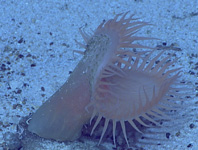Abstract
The diversity of burrowing sea anemones from Brazil is poorly known with only three species recorded. Metapeachia schlenzae sp. nov. is described from specimens collected in the intertidal zone of São Sebastião and Cabo Frio in the southeastern coast of Brazil. Metapeachia schlenzae sp. nov. is the second species described for the genus and the second haloclavid recorded from Brazil. A comparison between Metapeachia schlenzae sp. nov. and Metapeachia tropica, the type species of the genus, is included. The two valid species of Metapeachia differ in the morphology of the conchula, internal anatomy, cnidae and geographical distribution.
References
Badham, C. (1917) On a larval actinian parasitic in a rhizostome. Quarterly Journal of Microscopical Science, 62, 221–229.
Carlgren, O. (1943) East-Asiatic Corallimorpharia and Actiniaria. Kungliga Svenska Vetenskapsakademiens Handlingar, 20, 1–43.
Carlgren, O. (1949) A survey of Ptychodactiaria, Corallimorpharia and Actiniaria. Kungliga Svenska Vetenskapsakademiens Handlingar, 1, 1–121.
Corrêa, D.D. (1973) On the sea anemone Actinoporus elegans Duchassaing. Publications of the Seto Marine Biological Laboratory, 20, 157–164.
Daly, M., Chaudhuri, A., Gusmão, L. & Rodriguez, E. (2008) Phylogenetic relationships among sea anemones (Cnidaria: Anthozoa: Actiniaria). Molecular Phylogenetics and Evolution, 48, 292–301.
http://dx.doi.org/10.1016/j.ympev.2008.02.022Daly, M., Fautin, D.G. & Cappola, V.A. (2003) Systematics of Hexacorallia (Cnidaria: Anthozoa). Zoological Journal of the Linnean Society, 139, 419–437.
http://dx.doi.org/10.1046/j.1096-3642.2003.00084.xDaly, M., Lipscomb, D.L. & Allard, M.W. (2002) A simple test: evaluating explanations for the relative simplicity of the Edwardsiidae (Cnidaria: Anthozoa). Evolution, 56, 502–510.
http://dx.doi.org/10.1111/j.0014-3820.2002.tb01361.xDaly, M., Rack, F. & Zook, R. (2013) Edwardsiella andrillae, a new species of sea anemone from Antarctic Ice. PLoS ONE, 8 (12), e83476.
http://dx.doi.org/10.1371/journal.pone.0083476Elmhirst, R. (1915) Notes on anemones from the Millport Marine Biological Station. Zoologist, 19, 21–24.
England, K.W. (1987) Certain Actiniaria (Cnidaria, Anthozoa) from the Red Sea and tropical Indo-Pacific Ocean. Bulletin of the British Museum, 53, 205–292.
Fautin, D.G. (2013) Hexacorallians of the World. Available from: http://geoportal.kgs.ku.edu/hexacoral/anemone2/index.cfm (accessed 20 July 2015)
Fautin, D.G., Zelenchuk, T. & Raveendran, D. (2007) Genera of orders Actiniaria and Corallimorpharia (Cnidaria, Anthozoa, Hexacorallia), and their type species. In: Zhang, Z.K. & Shear, W.A. (Eds.), Linnaeus Tercentenary: Progress in Invertebrate Taxonomy. Zootaxa, 1668, pp. 183–244.
Gomes, P.B. & Gusmão, L. (2003) First Record of the genus Haloclava Verrill, 1899 (Actiniaria: Haloclavidae) from the South American Coast. In: Annals of the 7th International Conference on Coelenterate Biology. University of Kansas, Lawrence, pp. 51.
Gosse, P.H. (1855) Description of Peachia hastata, a new genus and species of the class Zoophyta; with observations on the family Actiniadae. Transactions of the Linnean Society (London), 21, 267–276.
http://dx.doi.org/10.1111/j.1096-3642.1852.tb00463.xGoswami, B.C.B. (1992) Marine fauna of Digha coast of West Bengal, India. Journal of the Marine Biological Association of India, 34, 115–137.
Haque, M.M. (1977) Some littoral coelenterates of Bangladesh and Pakistan coasts. Bangladesh Journal of Zoology, 5, 33–40.
Humason, G.L. (1967) Animal Tissue Techniques. WH Freeman and Company, San Francisco, 569 pp.
Lauretta, D., Rodríguez, E. & Penchaszadeh, P.E. (2011) A new vermiform sea anemone (Anthozoa: Actiniaria) from Argentina: Harenactis argentina sp. nov. Zootaxa, 3027, 9–18.
Mariscal, R.N. (1974) Nematocysts. In: Muscatine, L. & Lenhoff, H.M. (Eds.), Coelenterate biology: reviews and new perspectives. Academic Press, New York, pp. 129–178.
Menon, K.R. (1927) Subclass Zoantharia (except Scleractiniae). Bulletin of Madras Government Museum (Natural History Section), 1, 31–40.
Mitra, S. (2010) Cnidarian fauna in wetlands of West Bengal. Journal of Environment and Sociobiology, 7, 133–139.
Panikkar, N.K. (1938) Studies on Peachia from Madras. Part I. On a new species of Peachia from Madras. Proceedings of the Indian Academy of Sciences, 78, 182–205.
Parulekar, A. (1966) Cnidae in the actinians of Maharashtra. Journal of Biological Science, 9, 36–42.
Parulekar, A. (1968) Sea anemones (Actiniaria) of Bombay. Journal of Bombay Natural History Society, 65, 138–147.
Parulekar, A. (1990) Actiniarian sea anemone fauna of India. Proceeding of marine biodeterioration with reference to power plant cooling systems, IGCAR, Kalpakkam, 26–28 April 1989. National Institute of Oceanography, Goa, India, 218–228.
Rodríguez, E., Barbeitos, M.S., Brugler, M., Crowley, L., Grajales, A., Gusmão, L.C., Häussermann, V., Reft, A. & Daly, M. (2014) Hidden among sea anemones: the first comprehensive phylogenetic reconstruction of the Order Actiniaria (Cnidaria, Anthozoa, Hexacorallia) reveals a novel group of Hexacorals. PLoS ONE, 95, e96998.
http://dx.doi.org/10.1371/journal.pone.0096998Rodríguez, E., Barbeitos, M., Daly, M., Gusmão, L.C. & Häusserman, V. (2012) Toward a natural classification: phylogeny of acontiate sea anemones (Cnidaria, Anthozoa, Actiniaria). Cladistics, 28, 375–392.
http://dx.doi.org/10.1111/j.1096-0031.2012.00391.xRodríguez E. & Daly, M. (2010) Phylogenetic relationships among deep-sea and chemosynthetic sea anemones: Actinoscyphiidae and Actinostolidae (Actiniaria: Mesomyaria). PLoS ONE, 5 (6), e10958.
http://dx.doi.org/10.1371/journal.pone.0010958Rodríguez, E. & López-González, P.J. (2002) A new species of Halcampella (Actiniaria, Halcampoididae) from the eastern Weddell Sea and Antarctic Peninsula. Scientia Marina, 66, 43–52.
Rodríguez, E. & López-González, P.J. (2003) Stephanthus antarcticus, a new genus and species of sea anemone (Actiniaria, Haloclavidae) from the South Shetland Islands, Antarctica. Helgolander Marine Research, 57, 54–62.
Schlenz, E. (1985) Primeira ocorrência de uma anêmona-do-mar da Família Haloclavidae no Brasil. XII Congresso Brasileiro de Zoologia. Sociedade Brasileira de Zoologia, Campinas, 15 pp.
Silva, J.E., Lima, C.A.C, Perez, C.D. & Gomes, P.B. (2010) First record of the sea anemone Nematostella vectensis (Actiniaria: Edwardsiidae) in Southern Hemisphere waters. Zootaxa, 2343, 66–68.
Da Silveira, F.L. & Morandini, A.C. (2011) Checklist dos Cnidaria do Estado de São Paulo, Brasil. Biota Neotropica, 11 (1a), 1–11.
http://dx.doi.org/10.1590/s1676-06032011000500016Stephenson, T.A. (1928) The British sea anemones. Vol. I. The Ray Society, London, 148 pp.
Stephenson ,T.A. (1935) The British sea anemones. Vol. II. The Ray Society, London, 426 pp.
Zamponi, M.O., Belém, M.J.C., Schlenz, E. & Acuña, F.H. (1998) Distribution and some ecological aspects of Corallimorpharia and Actiniaria from shallow waters of the South American Atlantic coasts. Physys, 55, 31–45.

